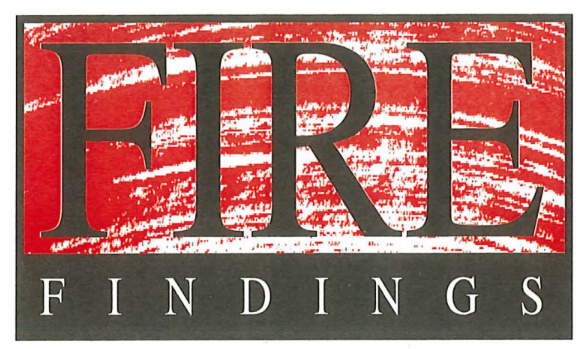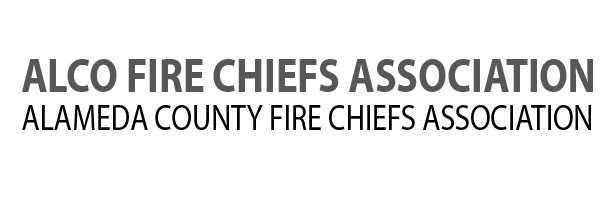
Fire Findings’ is a written publication with its first issue published in April 1993 and printed their final hardcopy newsletter in the Fall of 2010. The goal of the publication is to provide fire investigators with the most practical, current, and useful source of fire origin/cause information.
The Alameda County Fire Chiefs have purchased the back issues of Fire Findings for use by the Fire Investigation Group tasked with fire origin and cause determination.
To Report Issues with page, email [email protected]
In this issue are the following topics and more:
- Electrical Baseboard Headers
- How Smoke Detectors work and Why they May not Work
- Operating Temperatures of an Electric Iron
- Electrical receptacles not in use can cause fires.
- Special Report: Gas Water Heater Fires
- Kitchen fires: It pays to know what’s cooking.
In this issue are the following topics and more:
- First in a series: Electricity 101 for fire investigators.
- Tip-over switches make heaters virtually foolproof.
- Hearth extension is an important consideration in your investigation.
- SPECIAL REPORT: Gas Furnace Fires
- Popular extension cord reels can be dangerous.
- NFPA Section 921 premieres: faulty indicators.
In this issue are the following topics and more:
- Concrete core sections may increase chances of identifying accelerants.
- Burn tests show one bag of potato chips fuels fire.
- How hot does a toaster get?
- How propane tank vapor withdrawal valve works.
- Special Report: floating neutrals – how to check continuity to ground and a checklist for determining the problems.
- Exclusive smoke detector burn tests: Don’t make assumptions about the presence of them.
- NFPA 921: fire patterns.
In this issue are the following topics and more:
- Gas leaks: Joints are common sources for problems.
- Relays are important parts of HVAC systems.
- Electric radiators – How hot do they get?
- NFPA 921 – Heed advice about red flags.
- Special report: Noted authority, James M. Finneran, explains how coffeemakers work and fail. Includes a list of coffeemaker recalls.
- X-rays: Nondestructive exams can lead to accurate determinations.
In this issue are the following topics and more:
- Loose gas pipe fittings: Physics basics may aid investigation.
- Plug fuses halt current almost instantly.
- Hair dryer temps make good comparisons.
- Curing fiberglass resin creates chemical reaction but no fire.
- Special Report: Electrical apparatus remains.
- Add smoke detectors to your list of potential fire causes (plus list of smoke detector recalls).
In this issue are the following topics and more:
- Cigarette fires in paper trash: Results difficult to believe, even after 300 tests.
- New Bureau of ATF FIRE Center slated.
- How hot does a dimmer switch get?
- Burn patterns on floors may not indicate arson.
- Special Report: heat release rate (Part I).
- Circuit protection devices respond differently depending on situation.
In this issue are the following topics and more:
- New cord fault circuit interrupter (CFCI) technology designed to detect fire-causing conditions.
- Cord abuse testing leads to higher temps, internal arcing.
- New Dex Wipe Warmer’s temps much lower than recalled product.
- NFPA 921: Tape recording statements doesn’t need to be distracting or annoying.
- Special Report: Eyewitness Memory / Interviewing Tips / Swiss Nanny arson-murder case.
- Part II — Clothes dryer lint: Testing reaffirms spontaneous heating of lint is unlikely.
In this issue are the following topics and more:
- Prefabricated chimneys: Proper installation and precautions reduce risks associated with use.
- Ceramic heater acts fast when overheated.
- Special Report: Part I. Panelboard examinations.
- NFPA 921: Proposed changes to next edition could have substantial impact.
- Insulation analysis: Cellulose and mineral wool look deceptively alike but similarity stops there.
- Learning to narrow Web results can be the key to successful on-line searching.
In this issue are the following topics and more:
- Floor-level burning: What kinds of damage do burning accelerants cause?
- How Hot Does It Get: soldering iron operating temperatures.
- Uniform symbols to use for diagramming electrical systems.
- Special Report: Utility voltage control.
- NFPA 921: fire scene reconstruction and prefire positioning.
In this issue are the following topics and more:
- Exterior electrical exams: Important aspect of fire scene exam.
- WAAS-enabled GPS receives may have applications for larger fire-scene work.
- Operating temperatures of a multi-cooker (countertop deep-fat fryer).
- Input for 2004 edition of NFPA 921 due soon.
- Special Report: Forced Entry.
- Kirk’s author, John DeHaan, adds to V-pattern discussion (excerpt of new edition also included).
In this issue are the following topics and more:
- Masonry fireplaces: Improper construction years ago may lead to fires today.
- Occupational health and safety: Risks still present after fire extinguishment.
- Roof de-icing cable requires extra care (operating temperatures test).
- Look for fuel gas as an influence on fire development or as a cause.
- Special Report: electric blanket fires (Part I) plus how to handle, preserve crucial components.
- How the mechanical electric meter works.
In this issue are the following topics and more:
- Voltage required to cause arcs and sparks.
- LP-gas tank top heater operating temperatures.
- NFPA 921: User’s Manual premieres.
- Special Report: methamphetamine lab fires.
- Alarm systems: gaining crucial info after a fire.
In this issue are the following topics and more:
- Electric space heaters (Part II): Clues to determining if this appliance caused a fire.
- CPSC seeking electrical panelboards and receptacles involved in fires.
- Melted fluorescent light bulb and recall of them.
- Special Report: Protocol primer.
- Using pre-fire photographs to capture essence of burned structures.
In this issue are the following topics and more:
- A matter of inches: Slight changes in variables make a difference in resulting test fires.
- How instant-demand (tankless) water heaters work.
- Wire nuts, aka pressure-type wire connectors, are tiny parts that perform a big job in any wiring project.
- Special Report: high-efficiency gas furnaces.
- When flame-rollout leads to fires.
In this issue are the following topics and more:
- Part I: The Testifying Investigator – Consideration of litigation begins at the scene.
- NFPA 921: Committee issues proposal report.
- What’s Inside: Mechanical timer controls the operation of an appliance.
- Phantom power: devices turned off” may create fire hazards.
- Special Report: Interviewing Occupants (Part I).
- How it Works: Battery chargers.
- Part I: The Testifying Investigator – Consideration of litigation begins at the scene.
- NFPA 921: Committee issues pro”
In this issue are the following topics and more:
- Gasoline vapor testing: What makes a competent ignition source?
- Residential Electricity for Fire Investigators: New Fire Findings seminar makes debut.
- What’s Inside: capacitor motor.
- NFPA 921: Addition of guidelines could improve interviewing section.
- Special Report: smoke alarm evaluations.
- Case study: The Missing Firebox.
In this issue are the following topics and more:
- Improper fireplace use: problems run the gamut.
- What do the markings on circuit breakers mean?
- Special Report: Refrigerator fires.
- How it Works: Instant-demand gas water heater.
- Was the switch on or off? X-rays may provide the answer.
In this issue are the following topics and more:
- Fire-safe cigarettes: Are they really less likely to ignite other combustibles?
- Cellulose at the seminar: Attendees get unexpected bonus” with wood-burning stove demonstration.
- What’s Inside: Humidifiers.
- Special Report: Barometric kerosene heaters.
- NFPA 921: Time to comment on proposals for 2011 edition.
- X-ray Vision: Gas shutoff – was it open or closed?
- Cellulose at the seminar: Attendees get unexpected “bonus” with wood-burning stove demonstration.
